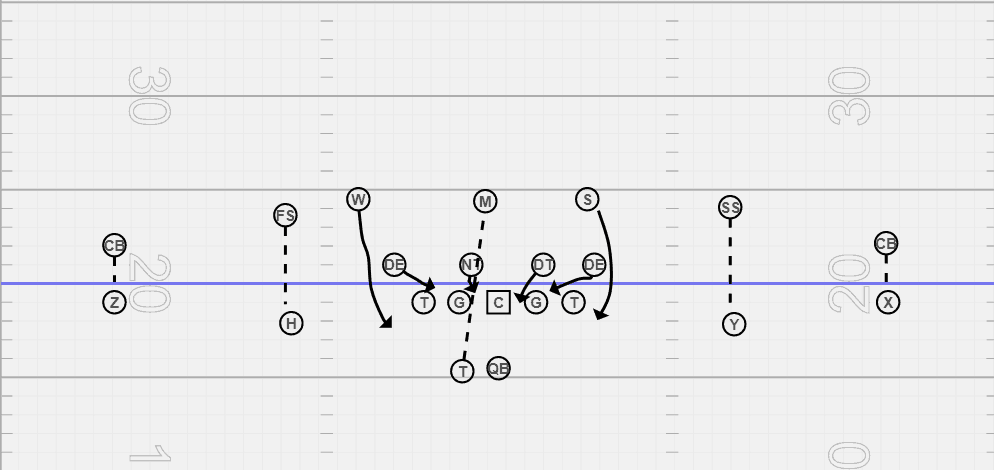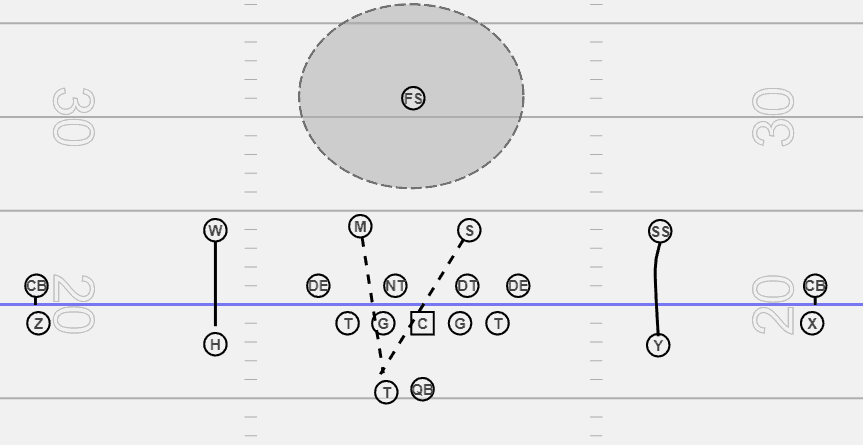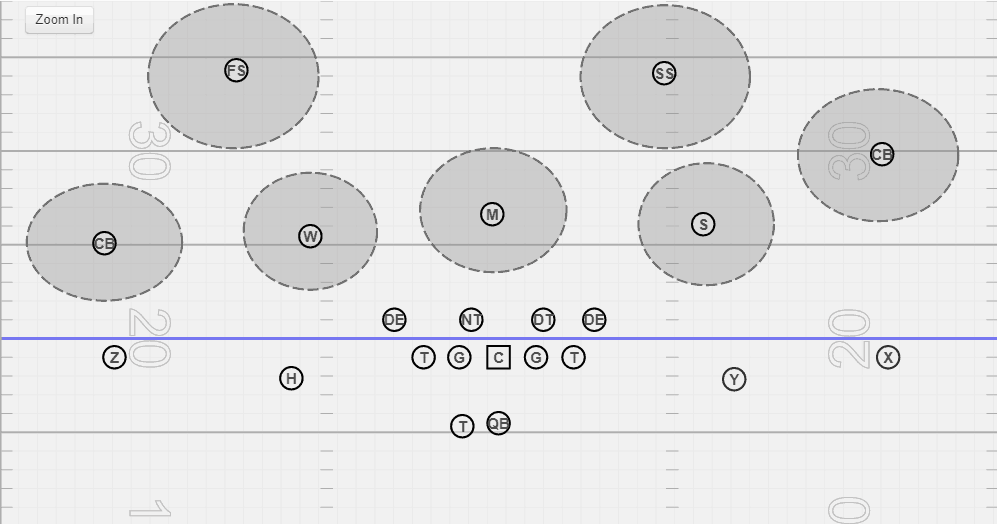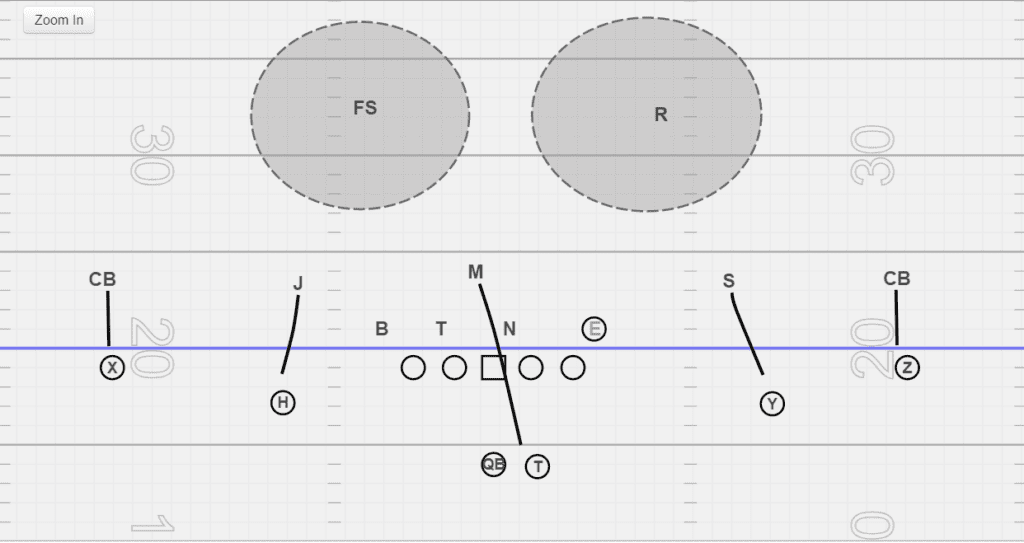Football coverage is how the defense counters against the offense’s passing attack. In today’s world of the spread offense, defenses need to be stout in stopping the aerial attack from the offense.
Defensive coverages in football include cover 0, cover 1, cover 2, cover 3, and Cover 4.
This article will break down all of the top coverages that teams use to stop passing attacks.
Football Coverages
There are two types of coverage in football, man and zone coverage. Here are the differences between the two:
Man Coverage – When one defensive player follows the offensive player wherever they go. The defense’s only responsible for that play is to cover that man.
Zone Coverage – Each player on the defense has a role or responsibility to cover a certain area on the field. Areas of the field are identified as zones in football. Depending on the coverage, the areas and zones will change.
Coaches will choose to play certain coverages over others based on players’ strengths and overall philosophy.
Cover 0

Cover 0, also known as man coverage, is when the defense blitzes six defenders and leaves a mix of 5 defensive backs and linebackers to lock on to one defender. There are two types of man coverage. Those two types are:
Press Coverage – As you learned in the previous lesson, press coverage is when a defender typically lines up 1-2 yards away from the wide receiver to disrupt his timing and get off.
Off-Man – Off-man is exactly like it sounds, playing man coverage by 4-5 yards depth. Players can collide routes to slow them down in college and high school. The NFL requires players to get a bit more depth to run vertically with routes.
The most basic coverage in football. Cover 0 is a man-to-man coverage when the defense does not play zone. The defense’s goal in cover 0 is to prevent yards after the catch for the offense.
The defense will be responsible for each eligible receiver on the offense (5 receivers). This means the defense will likely be blitzing six players toward the quarterback.
Cover 0 is a great way to pressure the offense; however, it is a high-risk, high-reward coverage. If one of the defensive players loses in man-to-man coverage, it will often result in a big play or a touchdown.
Set up in short-yardage situations, and cover 0 can be very effective against an offense unprepared for it.
Cover 1

Cover 1 is similar to cover 0. Instead of blitzing six players, the defense will run a dog (5 man pressure), play man coverage, and have one extra defender to play the middle of the field (MOF).
Techniques Played Out Of Cover 1: Press Man, Off-Man, 1-Rat, Double Team, QB Spy.
1- Rat – This technique is common for teams that play Cover 1. It involves the safety who plays the deep middle of baiting a crossing or out breaking route and steal an interception. It works because the QB will see a single high safety and anticipate that he’ll be playing deep. On the snap of the football, he’ll move to his position to steal an interception.
Double Team – As simple as it sounds, the single high safety can be used to give added support to a weak-man coverage defender. The safety will shade over that offensive player pre-snap or post-snap.
QB Spy – For teams with a mobile Quarterback, defenses will use the extra defender to “spy” (in other words, follow the quarterback wherever he goes).
Cover 1 is a variation of cover 0. The only difference between the two is that instead of man-to-man coverage, the defense will play zone in one deep field area, often occupied by one safety.
This coverage is a great way to mitigate any risk from playing man-to-man coverage. In cover 0, there are 0 deep defenders. In cover 1, there is one deep defender in the middle of the field.
This coverage will be up to one defensive back to make any adjustments needed against a good passing attack and support any players who lose in their man-to-man coverage.
Learn How To Watch Film Properly…
Uncover your opponent’s offensive and defensive tendencies so you can easily build a game plan.
Inside You’ll Find:
- Strategies to pick apart defenses
- How to identify player weaknesses
- How to save time in your weekly breakdowns
Cover 2

Cover 2, as we know, requires two deep defenders and five underneath defenders. The corner position will play the “flats.” This requires a wide base to reroute wide receivers that cross the corner’s zone.
The cover 2 technique is different from the other techniques on this list mainly because the corner will play an underneath zone rather than backpedal to cover a deep zone.
Cover 2 is effective when run correctly because it splits the deep coverage between 2 players, giving them each half of the field to work with.
Tampa Bay Buccaneers used a variation of the cover 2 in the early 2000s called the Tampa 2 defense, which allowed the Mike linebacker to run through the field to add more presence in the middle of the field.
Teams who are adept at running deep routes can succeed against this coverage by taking advantage of the deep defenders. Cover 2 is still good for many teams because it’s very versatile and effective against run and pass games.
Cover 3

The techniques with the corner and the safeties start to blend as we talk about cover 3 and cover 4. For Cover 3, the corner has to worry about protecting the deep ball.
Cover 3 is best known for its variation with 4 underneath defenders, which leaves one safe on an island in the middle of the field, covering his designated area.
Like cover 0, the goal in cover 3 is to stop yards after the catch. The difference is that instead of following the receiver, all 4 defenders are responsible for a deep area of the field, effectively removing any risk in playing man-to-man coverage.
Cover 3 is great coverage for run defense but not as effective against the pass. It still leaves one defender living on an island, which adds a ton of stress and responsibility to that defender.
Cover 4

Cover 4 is what most teams run to ensure no deep balls are caught. Like cover 3, the technique is played with a skinny base for vertical transitioning.
There are four deep defenders, two corners protecting the sideline zones, and two safeties in the middle of the field. Cover 4 can be used in many aspects of defensive play, such as against the run and pass game.
Cover 4 is popular with teams running 4-2-5 schemes and 4-3 schemes. There are two types of cover 4, spot drop and man-match.
Players will drop to a zone in spot drop and play in their designated area. If you play man-match, you’re pattern-matching the wide receiver’s route.
Cover 5
In cover 5, there are five underneath defenders playing man coverage and two deep defenders playing 1/2 the field (like cover). This coverage is also known as 2-man or cover 2-man.
Cover 5 is great coverage for preventing big plays. It’s also a good coverage for defending against passes because it protects against any vertical passes.
Teams will often use Cover 5 in passing situations such as 3rd down or 4th and long situations.
Palms Coverage
Also known as robber or trap coverage, palms coverage is how defenses will protect themselves against offenses that throw flat or bubble routes.
The premise of Palms coverage is for the corners to read the #2 receiver. The corner will cover him as soon as the receiver runs to the flats. The safety will then run to the #1 receiver and cover him. This is a changeup to cover 2 or cover 4 coverage.
Learn More About Palms Coverage Here
Split Field Coverages
With the popularity of 3 high safeties and the 4-2-5 defense, teams have opted to play split field coverages instead of full-field coverages.
This gives the defense flexibility to play different coverages based on the defense’s formations. They put themselves in the best matchup possible vs. the spacing and skill level of the offense. If teams are run-heavy, they can add more players into the box.
If the offense is pass-heavy, coaches can elect to play a softer style of defense. Coaches have combined all of these coverages to combat the offense’s aerial attack.
Cover 6

Cover 6, also known as “quarter, quarter, half,” is a split field coverage with one side playing cover 4 and one side playing cover 2.
The coverage will steal techniques from both cover 2 and cover 4.
Cover 6 is a split field coverage that combines cover 4 and cover 2. Put them both together, and you get cover 6.
Teams who want to stay in their two-high safety look will often play cover 6 to any offense sets that feature 3×1. This allows teams to have even spacing across the field and play all the zones to cover the receivers.
Keep Learning
Learn more about coverages in football below.
What Are The Nickel Dime & Quarter Packages In Football?
What Is A Zone Blitz In Football? Explained
What Is Cover 5 In Football? 2-Man Explained
Cover 4 In Football: Coverage Guide
What Is Cover 0? Learn The Basics Of Man Coverage
Learn The Basics Of Cover 1 In Football
Split Field Coverage In Football
What Is Cover 2 In Football? Explained
What Is Cover 3 In Football? Explained
Zone and man coverage are the two kinds of defensive coverage. Teams will often use various coverages to best combat the offense.
The number that comes after the word “cover” is how many deep defenders there are. Teams will use these coverages based on the skill level on defense and how their players can retain their responsibilities.
Let’s keep learning! Our learning center is packed with information regarding techniques, schemes, and more!
If you’re looking for more in-depth breakdowns & coaching resources, visit our coaching resource page here.
Do you have additional coverages that we should add? Let us know in the comment section below!



